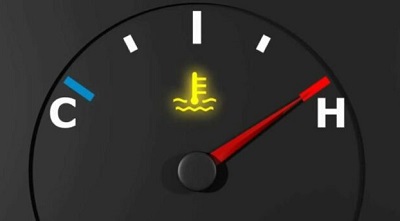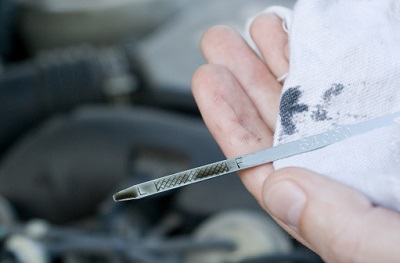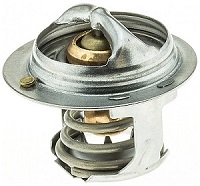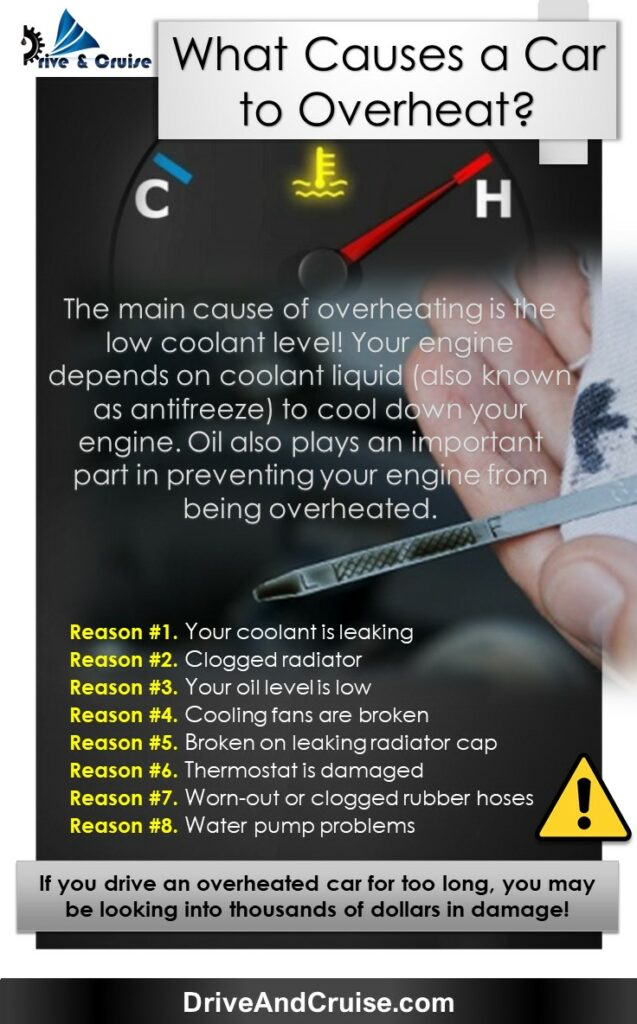![]()
What Causes a Car to Overheat? [8 Reasons]
DISCLAIMER: AS AN AMAZON ASSOCIATE I EARN FROM QUALIFYING PURCHASES. THIS POST CONTAINS AFFILIATE LINKS THAT WILL REWARD ME MONETARILY OR OTHERWISE WHEN YOU USE THEM TO MAKE QUALIFYING PURCHASES. FOR MORE INFORMATION, PLEASE READ MY EARNINGS DISCLAIMER.
|
The main cause of overheating is the low coolant level! Your engine depends on coolant liquid (also known as antifreeze) to cool down your engine. If it’s not flowing properly through your engine, you will have a problem.
Oil also plays an important part in preventing your engine from being overheated. Sufficient lubrication of your engine’s components will not allow them to rub against each other and produce heat.
If you drive an overheated car for too long, you may be looking into thousands of dollars in damage! Overheating is preventable (in most cases) by regular maintenance and checking of your coolant and oil levels.
The first thing to do if your car is overheating:
Pull over ASAP and call for assistance!
DO NOT keep on driving! Once you are in a safe place and waiting for somebody to take your car to the shop, now we can look at the reasons for car overheating.
Don’t forget that your car could be OVERHEATED even though you don’t see steam coming out of your engine! If the arrow inside your gauge points to “RED”, your car is OVERHEATED:

The following are the possible reasons for your car being overheated:
Reason #1. Your coolant is leaking
Let’s start with the basics! Leaking coolant is the most common reason for the overheated car. This leak could be anywhere within your vehicle’s cooling system, which includes:
- Hoses.
- Radiator.
- Water pump.
If you keep on adding coolant to your car or notice a puddle of coolant on the ground, – you have a leak somewhere! One of the ways (and most inexpensive one) to check where the leak is coming from is to use a UV (ultraviolet) dye:
If the leak is not found via UV, do a pressure test. Checking for coolant leaks is the FIRST thing you should do to determine why your car is overheating!
Reason #2. Clogged radiator
Besides the leaks that I mentioned above, your radiator could be clogged due to corrosion and debris. Since coolant must move freely through your radiator, if it’s clogged, your engine will overheat.
You also want your coolant to be clean inside your radiator. Follow your manufacturer’s suggestions on when the coolant needs to be completely changed to avoid clogging the radiator in the future.
Radiators of modern cars do not flush out well (the holes got smaller), but they are also not too expensive and should be replaced when needed:
Following is a maintenance suggestion. If your car is overheated right now, do NOT touch or try to measure anything and get it to the repair shop!
You can check if your radiator is clogged up by using a digital infrared thermometer. Pointing this device to any part of the radiator (when the car is running) will give you the accurate scanning of temperature in that specific section:

If you find that most of your radiator is hot and this little area is cold, that means your radiator is clogged and is not dissipating heat properly. Get this useful tool Etekcity Lasergrip 800 (paid link) from Amazon and safely check the temperature.
** Side note. This special device is NOT for taking human temperature!
Reason #3. Your oil level is low
If your engine is not being lubricated properly, the rotating components will rub against each other and create friction. Friction will generate excessive heat and cause overheating of your engine.
You can check your oil pressure level by looking at the gauge on the dashboard of your vehicle:

Even if you get no electronic signs of oil problems (especially if your engine is making weird noises), you should check your oil level by using a dipstick. This is not intended to be checked in the moment of overheating!
Once the car is cooled down, this test will be safer. Your oil level should be in the middle region, like in the picture below:

Checking your oil levels is very useful to do as a part of a regular maintenance procedure. Usually once a month, or any time you pull up to fill a gas tank.
Don’t forget to shut your engine down and let the oil settle before taking your measure. Another problem that you could be facing is an oil leak, so check for oil puddles under your car.
Reason #4. Cooling fans are broken
You can check if your cooling fans are working by turning your Air Conditioning ON to full power. If you notice one or both cooling fans not working, the strain that A/C is putting on your engine is causing the car to overheat.
Cooling fans are very important since their main job is to remove heat from the radiator. They need to turn ON and OFF all the time, especially if your A/C is ON.
If your cooling fan is not working, your car will overheat. Let your mechanic check the electrical circuit of your fan and replace it if needed.
Reason #5. Broken or leaking radiator cap
Also, make sure your radiator cap is in good working condition with no leaks. It is a crucial component of the cooling system because it is specifically designed to catch coolant overflow and keep the whole system under pressure.
These caps can get worn out and not seal your coolant system properly, so you may want to get a new one every 4-5 years.
Reason #6. Thermostat is damaged

The thermostat is a neat little device that your engine also relies on. It controls the coolant flow and allows it to enter the car’s radiator when it gets to a certain temperature.
If the thermostat will not open its valve to let coolant in when needed, overheating will be a result. This is not a very common cause of engine overheating, but you definitely don’t want this thing to malfunction while you are driving down the road!
If you do regular maintenance and change your thermostat every 4-5 years (or whatever the manufacturer recommends), it will be in good working condition. When you will be deciding on which thermostat to get, get a good quality one (“OEM” – Original Equipment Manufacturing).
Cheaper versions fail and break more often. Take care of your baby! Here is more information on thermostats:
Reason #7. Worn-out or clogged rubber hoses
Hoses play an important role in a radiator cooling system. They carry coolant to and from the radiator. If they are cracked or clogged, you will have an overheating problem.
Ask your mechanic to check and replace old hoses if needed. In order to avoid this problem in the future, you may want to use this liquid to rejuvenate your rubber and stop leaks AT-205 reseal (paid link).
Works great on ALL rubber surfaces!
Reason #8. Water pump problems
Without a water pump, cooling fluid cannot circulate properly through your cooling system. If it’s broken, your engine will NOT be getting the cooling that it needs and the engine overheating will follow.
It is responsible for creating pressure that delivers a coolant fluid to your engine. Anything from corrosion to electrical problems could cause the water pump to malfunction and you need to ask a professional to check it out.
If the water pump belt is broken, you will have a problem as well.
Feel free to save the infoPin below for your future Reference :
What to do when the engine overheats?
The FIRST thing you need to do in this situation is to find a way to cool your car down as soon as possible before irreversible damage is done! The WORST thing you can do – is to keep on driving (even if just for a little bit).
Here are some symptoms of an overheating car (more in this article):
- The temperature gauge is pointing at RED.
- STEAM is coming out from under your hood.
- You notice coolant or oil leaks.
- Unusual noise is coming from your engine.
- It starts smelling like something is burning.
So, how do you handle an overheated car?
Situation #1: If you are on the road
First of all:
Try to get off the road as soon as possible!
If you are on the road and your air conditioner is ON, turn it OFF and watch the gauge. If the temperature starts to drop, you could have problems with your cooling fans.
It may seem illogical, but turning your heater ON can actually help your engine to cool down! This is not a long-term solution, but it should be enough to find a safe place to stop without damaging your engine.
Situation #2: If you are NOT on the road
Once off the road, turn OFF your engine and let it cool for at least 10 min. Open a hood and let the steam evaporate. After the car cools down, turn the ignition to the ON position and check the gauge (without starting).
If you are still in “RED”, get your vehicle towed to the nearest shop. If your temperature is within normal ranges, refill the coolant fluid and try staring at the engine. If everything is fine there, you should be able to get to the nearest repair shop by yourself.
If your engine starts to make all kinds of noises, turn the engine OFF and call for roadside assistance. Check the map below for nearby mechanic:
Attention! This article is for informational purposes ONLY and is NOT a replacement for professional advice! ALWAYS consult your local specialist for an appropriate solution to your problem. All statements, prices, contact information, recommendations, and reviews contained herein came from sources that we believe to be reliable, but the accuracy or completeness thereof is not guaranteed. Please contact the service provider for complete details and updates.


